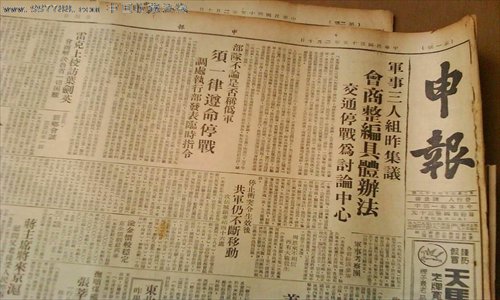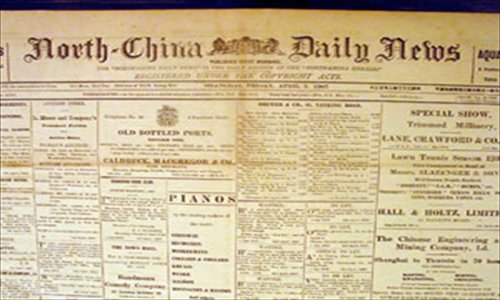The headlines that made history

Shanghai had no newspapers until it was opened to the outside world in the mid-19th century when foreigners published the first English-language newspaper here. The history of newspapers in the city reflects the history of the country and the city itself. The first few foreign newspapers began a flood of information broadsheets and tabloids throughout the country. Just before the People's Republic of China was founded, there were some 4,000 newspapers being published in China - more than 1,800 in Shanghai.
As invading countries turned Shanghai into the country's largest and most profitable colony in the 19th century, the foreigners in the vanguard needed newspapers to serve themselves and help inform and assimilate the Chinese. News agencies were set up and at the same time China's progressive intellectuals and revolutionaries used newspapers to change the way of thinking.
Information demand
In 1849, Shanghai overtook Guangzhou as China's premier port and was the fourth largest port in Asia. With trade came a demand for information. Large manufacturers and stores sent representatives abroad to collect information on innovations and trends. More people flooded into Shanghai looking for opportunities. They became in turn the readers and the sources for the newspapers.
Before the first foreign newspaper appeared in Shanghai, information was delivered by government bulletins but these were not always available to the general public. The Chinese government tightly controlled public opinion and anyone who was found publishing one of the clandestine handwritten newspapers that occasionally appeared could face jail or even beheading. Information was passed around by word of mouth.
Then the city newspapers began to blossom. Between 1865 and 1895, Shanghai saw 41 new foreign-language newspapers and 45 Chinese newspapers hit the streets. Most were published by foreigners.
In 1850, seven years after Shanghai opened its port, the city's first real newspaper was launched. Henry Shearman, a British auctioneer printed the first edition of the North China Herald on August 3. The Herald served the 100 or so British residents of Shanghai at that time. It was a four-page broadsheet published every Saturday. The front page was dedicated to news from Britain, especially news of the royal family, and advertisements for shops, insurance, real estate, auctions and banks in Shanghai. The second page contained opinion pieces and the third and fourth pages contained information about shipping, ports and trade. This was where details of the ships carrying opium that docked at the port could be found.
The North China Herald had similar content to a modern newspaper with advertisements and gossip alongside news and information. Although it was designed to meet the specific needs of the British in the city, it proved a foundation for Chinese newspapers.
In 1859, the Herald was authorized by the British consulate in Shanghai to publish official British government notices and was regarded as the official British organ for the region.

Breaking news
In 1861 the North China Herald's manager Charles Spencer Compton, a professional British newspaperman, established the city's first proper Chinese newspaper, the Chinese Shipping List and Advertisers, which provided all kinds of trade information and advertisements in Chinese. It was the first newspaper to be printed on both sides and the first Chinese newspaper to use headlines in its design.
In 1864, the daily edition of the North China Herald was launched, called the North China Daily News. And the Herald became a weekend edition. The North China Daily News focused more on news and sent reporters to remote areas in China. It also featured more opinion pieces on the relationships between China and other countries. The paper used missionaries to collect news and also signed a contract with Reuters for international news. It staunchly promoted British and American interests and was the most influential and longest-running English-language newspaper in Shanghai. It closed in March 1951 after a century of publication.
Following the British success, other newspapers sprang to life. From 1870 to 1890, Shanghai saw French, German, Japanese and Portuguese newspapers launched but most were short-lived. English-language newspapers dominated the market. As well as the North China Daily News, the evening newspaper the Shanghai Mercury, founded in 1879, was also very influential and widely read.
At the time when businessmen were establishing newspapers to meet a demand, missionaries were also launching newspapers trying to spread Christianity.
Two missionaries, Alexander Wylie and Alexander Williamson, published the first Chinese periodical the Shanghai Serial in 1857. Although they wanted to make it a newspaper, the Shanghai Serial articles mostly concerned religion, literature and science, and opened the door for Chinese intellectuals to begin expressing themselves in a new medium. The Serial folded after a year.
Important arrival
The most important Chinese newspaper in the city was the Shun Pao, the Shanghai News, which was launched in 1872 by a British businessman Ernest Maier and three friends. At that stage only one Chinese newspaper, the Chinese Shipping List and Advertisers, was being published and it had survived for 10 years but its limited coverage restricted its circulation to about 400 readers.
The Shanghai News arrived in a new format with more opinion pieces. Its front page could feature articles like "An opinion on Japanese men and women bathing together" alongside news items translated from foreign papers. Sometimes it translated works of fiction but ran them as if they were news. It also became popular because it ran articles by intellectuals for free - until then they had to pay to have opinions published.
At the start, the Shanghai News was published every other day but after four months it became a daily newspaper. It was so successful that the Chinese Shipping List and Advertisers was forced to shut down in 1872.
From the day the Shanghai News was created, it welcomed intellectuals who understood what the Chinese wanted to read as editors and chief reporters. When the Emperor Tongzhi of the Qing Dynasty (1644-1911) got married in 1872, the Shanghai News reported in detail what the emperor and his bride were wearing, the food that was served at the wedding banquet, the gifts that arrived and particulars of the ceremony.
The News was not popular with everyone and it had a stormy history, coming close to being shut on several occasions. In 1873 it reported the story of a Peking Opera performer who had fallen in love with the daughter of a rich Guangdong businessman and planned to get married. The family disapproved because opera performers were considered to be low class and it conspired with local officials to have the man arrested and thrown into prison where he was tortured which left him with a deformed foot. There were also reports saying it was the girl who had seduced the performer.
When the Shanghai News carried the story it expressed sympathy for the man and criticized the governor and the woman, reporting that women from Xiangshan in Guangdong were known to be flirtatious and many of them became prostitutes and foreigners' mistresses. The report angered Xiangshan people in Shanghai, who called for a boycott of the newspaper. Xiangshan businessmen and government officials set up their own newspaper in town to fight the News but the paper only lasted two years.
Publisher with purpose
In 1909, the Shanghai News was sold to a Chinese businessman Xi Yufu who ran it down somewhat leaving it with a circulation of just 7,000. In 1912 it was sold to Shi Liangcai, who made the Shanghai News the most influential Chinese newspaper of its time. By 1931 its circulation had reached 150,000.
Shi was born in 1880 in Nanjing, Jiangsu Province. He moved to Shanghai with his father, where his father ran a traditional Chinese medicine store. He gave up sitting the prestigious imperial examination after the failure of the Hundred Days' Reform movement in 1898. In 1904 Shi was appointed editor in chief of the Eastern Times, a newspaper established by Hundred Days' Reform movement backers.
After he took over the Shanghai News, he began publishing more articles about social welfare and reform. In 1915, Yuan Shikai, the president of the Republic of China (1912-1949), sent people to Shanghai to bribe the city's newspapers so that they would write favorably about his plan to become the emperor. The Shanghai News was an important target but Shi rejected the bribes and revealed the plot in the newspaper.
His battle with Beijing did not end there. After Yuan appointed himself emperor in 1916, he named his dynasty Hong Xian. But Shi Liangcai refused to use this title and the Shanghai News continued referring to the government as the Republic of China. Later the Japanese authorities forced him to use the term but he printed it in a typeface so small that it could hardly be read.
After the September 18 Incident of 1931 when the Japanese staged an attack to legitimize their invasion, Shi publicly expressed his love for his country through the newspaper. He said that the News should always try to represent ordinary people and not support any political party. Later the News criticized the Kuomintang attacks on the Red Army and published highly critical articles of Kuomintang leader Chiang Kai-shek. Chiang reportedly warned Shi one day: "Don't piss me off! I have a million soldiers." Shi retorted: "I'm sorry, but I have a million readers."
Shi was assassinated by the Kuomintang in 1934 but the Shanghai News continued, only stopping publication in May, 1949.
Political leanings
As well as the general newspapers in the city in the early days, several political journals thrived, basing themselves in the Shanghai concessions which protected them from the Chinese government. In the late Qing Dynasty papers and magazines like Wanguo Gongbao (A Review of the Times), Qiangxue Bao, Shiwu Bao, Min Li Pao spread ideas of constitutional reform and modernization, urging that the country learn from the West and adopt a capitalist system.
When the May Fourth Movement erupted in 1919, the Communist Party of China began publishing magazines and newspapers to promote the New Culture Movement. La Jeunesse, founded by Chen Duxiu in 1915, was one of the most influential Chinese magazines in the 1910s and 1920s. The Kuomintang also published newspapers like the Republican Daily News.
For most people then, the newspapers of choice were the tabloids which were racy, scandalous and highly entertaining. The tabloid newspapers reported bizarre stories, some of which may have been factual, and wrote a lot about celebrities. When the first tabloid, Youxi Bao (the Entertainment News) hit the streets in 1897, it published a list of the best prostitutes in the city. Other tabloids followed and in the 1920s, tabloids were carrying stories about how to gamble and how to have great sex with prostitutes. Academics sometimes supplied articles on entertainment. As the Qing Dynasty faltered, the tabloids took delight in mocking its government.
The most influential tabloid was Jing Pao (The Crystal) founded in 1919 which covered most aspects of life in a racy style. It closed in 1940. From 1897 to 1952, of the 1,786 newspapers published in Shanghai, 70 percent were tabloids. Today in China there remain about 1,900 newspapers with about 100 still being published in Shanghai.